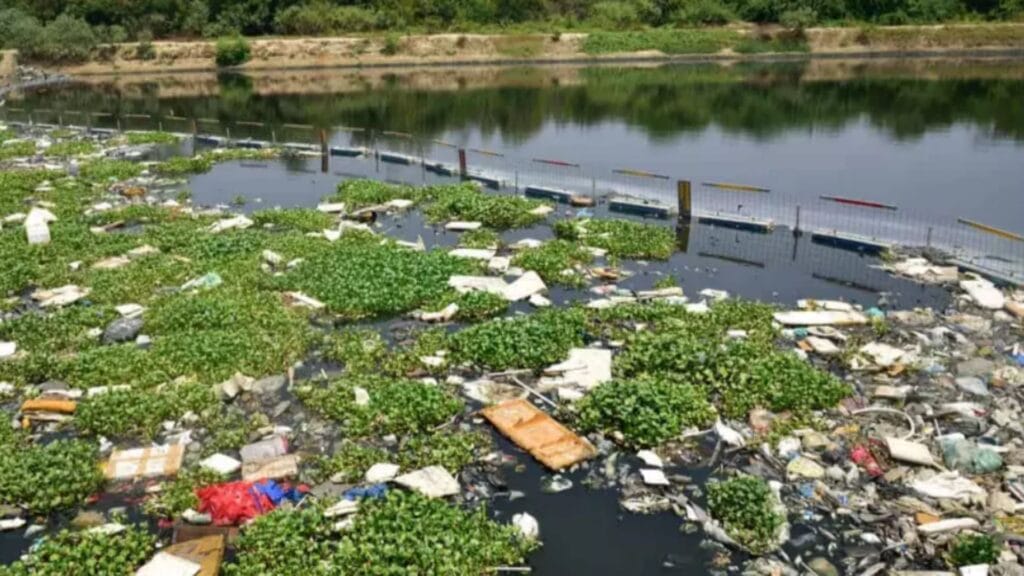In November last year, it was reported that the Greater Chennai Corporation (GCC) removed 600 tonnes of garbage and 250 tonnes of debris from water bodies over four months. The operation was a part of the desilting works undertaken by the administrative body to enhance the stormwater flow capabilities of the main canals. While it is not the sole reason for flooding during heavy spells of rain, indiscriminate waste disposal leads to clogged drain inlets and polluted water bodies that increase stagnation. Healthy water bodies can help tackle both water scarcity and flooding crises.
The GCC oversees 33 canals totalling a length of 53,241 metres. While desilting is carried out regularly throughout the year, the growing scale of the problem suggests that maintenance cannot be sustainable without cooperation from the public — for instance, an August 2023 piece in The Times of India carried a devastating account of the different types of garbage thrown into the Buckingham Canal in Mylapore, ranging from food and plastic to rubber and wood.
As urban, industrial and infrastructural development pick up pace, the city’s water bodies are at risk of severe pollution. Many have become dumping grounds for waste ranging from household garbage and domestic sewage to construction debris and industrial effluents.
Read more: Thazhambur Lake restoration brings fresh lease of life to the area
So, it was good to learn from recent news reports that the GCC has announced the formation of a Regional Enforcement Team to monitor the dumping of waste and debris in the Cooum and Adyar rivers, and other canals coming under its purview. The team will be led by Zonal Assistant Executive engineers and will also include solid waste management and conservancy supervisors, salary inspectors, tax collectors and workers.
A digital monitoring system has also been set up at 97 locations that were identified as vulnerable. The Solid Waste Management (SWM) department is reportedly filing complaints with the police to curb violations. It is presumed that the monitoring will include non-individual and commercial undertakings as well.
Need for an audit of water bodies
While the move is welcome, one hopes that a detailed audit of Chennai’s water bodies will also be conducted as part of the operations. It will serve the city well to understand how many water bodies it contains; and of these, how many are in good ecological shape, and how many require attention. Water bodies that have turned into de facto dumping grounds — legitimate or otherwise — can benefit from a renewed study from the administrative body.
Take the Pallikaranai marshland, for instance, which is a designated Corporation dump yard. Recently tagged as a Ramsar site, the Pallikaranai marshland has shrunk so much that reports say it covers not more than 10 percent of its original 5,500 hectares.
Read more: Ramsar Tag secured, what is the way ahead for the Pallikaranai marshland?
On the other hand, the ecologically sensitive area hosts a constantly expanding dump yard that covers hundreds of hectares. It is a resource that can help the city soak up water, but it is bogged down by solid waste pollution. A proper study can help the city identify and tackle known offences on priority — the Nolambur canal, for example, is dumped with several tonnes of garbage and food waste.
Raising awareness about natural resources
Guidelines from the National Green Tribunal (NGT) suggest going beyond the levying of fines to the creation of a green belt around the water resources. According to a June 2019 article in Mongabay, the belt is to comprise a buffer zone of 50-100 metres, which is to be maintained as a ‘no activity zone.’ The guidelines also suggest disseminating information about the water body at its entrance, so that the public can learn about the importance of the natural resources in their locality.
The NGT also suggests that ponds and lakes can be converted into recreational centres with boating activities, walkways and benches; this, it says, can help create a revenue stream that helps fund the operation and maintenance of the water body. These seem to be good ideas — while fines can help prevent offences in the short term, behavioural change is best won through a strong sense of community ownership to protect and sustain.
There needs to be a lasting collaboration between the administration and the public to restore and protect the city’s water bodies. It must be acknowledged that these resources are a critical cog in preventing the severity of water crises, whether of scarcity or flooding; they cannot be topics that are discussed merely during the monsoons and high summer months, and forgotten otherwise. Everyone has a duty towards these common resources, whether citizens, businesses or the government. It is hoped that the Regional Enforcement Team will gradually go beyond the levying of fines to bring about true change.
[This article first appeared in Madras Musings, Vol. XXXIII No. 18, January 1-15, 2024, and has been republished with permission. The original article may be read here.]
